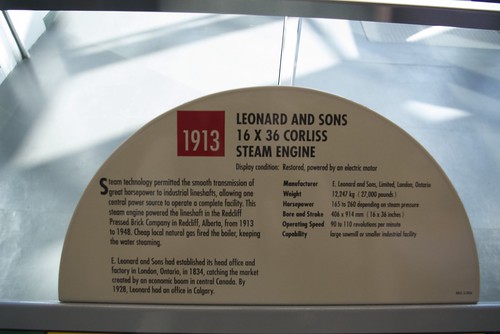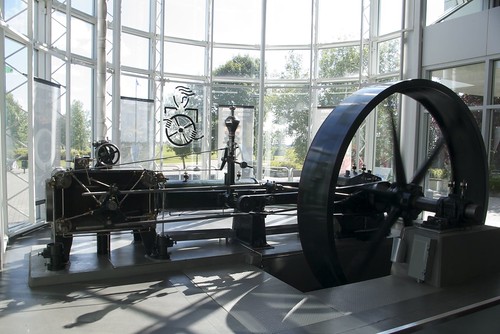The time.
Fort Edmonton
1905 Street, Fort Edmonton, Alberta, Canada

Corliss Steam Engine
This beauty is just inside the entrance to the Reynolds-Alberta Museum, Wetaskiwin, Alberta, Canada. I prevailed upon her good-self to stop off here for a few hours.
Happy Birthday Sputnik
Sputnik 1 was launched on the 4th of October, 1957.
iPhone and charging
I (deliberately) flattened my iPhone today so I could charge it with its own charger. I about 19:00 I plugged it in to my kill a watt meter to see how much power it uses. I’m assuming the meter isn’t all that accurate, and as it is designed to measure typical household loads its display is in kilowatt hours.
With it plugged in for 19 hours with no load, the kill a watt claims to have consumed 240 watt hours. Which means that it would consume approximately 31.5 watt hours for a 3 hour iPhone charge time.
After charging for 3 hours the iPhone apparently used 40 watt hours, subtracting the 31.5 above gives a results of approximately 8.5 watt hours.
Given the inaccuracy of the devices, that is close enough to the 10 in my previous post for me to say about 10 and roughly in the ballpark of the previous test. Time to go looking for more accurate measuring devices.
FASTRAC
1200mk: fm FAST2 to BEACON ctl UI pid=F0(Text) len 123 23:22:10
F21001633 38263.461363903952.94 -3773326.54 +4430538.23 +0.00000 +0.00000 +0.00000+1297283286 011 015 011 015 018
9600mk: fm FAST2 to FAST1 ctl SABM 23:26:59
9600mk: fm FAST2 to FAST1 ctl SABM 23:27:30
1200mk: fm FAST2 to BEACON ctl UI pid=F0(Text) len 123 23:28:10
F21001633 38263.461363903952.94 -3773326.54 +4430538.23 +0.00000 +0.00000 +0.00000+1315283286 009 014 010 015 019
1200mk: fm FAST2 to BEACON ctl UI pid=F0(Text) len 123 02:37:10
F21001633 38263.461363903952.94 -3773326.54 +4430538.23 +0.00000 +0.00000 +0.00000+1297283286 012 016 010 014 020
9600mk: fm FAST2 to FAST1 ctl SABM 04:21:00
9600mk: fm FAST2 to FAST1 ctl SABM 04:21:05
1200mk: fm FAST2 to BEACON ctl UI pid=F0(Text) len 123 07:43:09
F21001633 38263.461363903952.94 -3773326.54 +4430538.23 +0.00000 +0.00000 +0.00000+1321283286 007 013 009 018 019
iPhone and PV charging
A few weeks ago I was looking around the lab at the remnants of old projects and realised that we probably had enough bits to put together a solar powered charging station for phones. I.e. a 30 Watt PV panel (don’t buy from Farnell), a 12Volt Battery, and a PV charge controller.
I got an old 3 way cigarette lighter socket in Halfords, chopped the cable, added powerpoles, a fused connection to the battery and I now can charge my iPhone at my desk in work.
So, at break yesterday I was asked how much I was saving by charging my iPhone via solar energy. I had no clue, so I let my iPhone die completely last night and re-charged it while checking the charge current on a Watt’s up meter. I got tired of looking at it after 3 hours, but you can see the results on the graph below.
 For the first 2 minutes, it stayed steady at 360mA, then the phone switched on and it started charging normally. About 45 minutes at 340mA, before the current started to drop away. At 20ma charging current I stopped the experiment. If we allow a fudge factor for the accuracy of the Watt’s up meter, and the efficiency of the Apple charger (I was running the test off a DC supply) and say about 10watt/hours, that translates to 0.00129 cent per charge or thereabouts.
For the first 2 minutes, it stayed steady at 360mA, then the phone switched on and it started charging normally. About 45 minutes at 340mA, before the current started to drop away. At 20ma charging current I stopped the experiment. If we allow a fudge factor for the accuracy of the Watt’s up meter, and the efficiency of the Apple charger (I was running the test off a DC supply) and say about 10watt/hours, that translates to 0.00129 cent per charge or thereabouts.
FASTRAC
1200mk: fm FAST2 to BEACON ctl UI pid=F0(Text) len 123 08:41:05
F21001633 38263.461363903952.94 -3773326.54 +4430538.23 +0.00000 +0.00000 +0.00000+1348283286 008 014 007 014 024
1200mk: fm FAST2 to BEACON ctl UI pid=F0(Text) len 123 10:23:04
F21001633 38263.461363903952.94 -3773326.54 +4430538.23 +0.00000 +0.00000 +0.00000+1356283286 008 012 008 014 022
Arissat-1
Arissat-1 is hopefully going to be deployed late afternoon Irish time tomorrow, August 3rd. That means switched on and given a bit of a push away from the International Space Station (ISS) during EVA-29.
I was listening for it during testing over the weekend, my time was limited, but unfortunately I didn’t manage to hear any audio from it on the 145.950 downlink, from the mailing lists, it seems some could some couldn’t. As it is much weaker than the ISS
If all goes according to plan, the first areas that should be able to receive it will be South America, very southern South Africa and then southeast Asia.
Steve Bible, N7HPR is blogging about how it was designed and built over the next few weeks on Electronic Engineering Times called “Chips in Space – The Building of an Amateur Satellite“.
I’m looking forward to trying out the linear transponder on it, it will be interesting to see if I can use it with an Omni-directional aerial.




